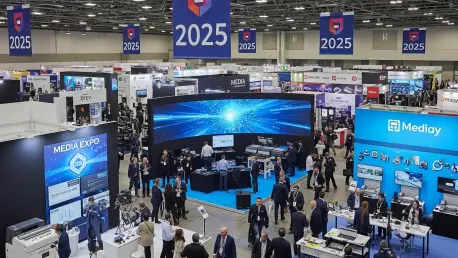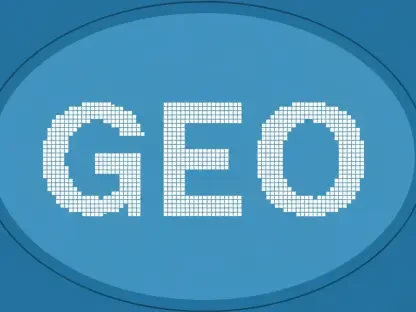Imagine walking into a sprawling venue where the future of advertising and visual communication unfolds before your eyes—smart digital displays interacting with passersby, eco-friendly printing solutions redefining sustainability, and industry leaders debating the next big trends. This was the scene at Bharat Mandapam in Pragati Maidan, New Delhi, during the 56th edition of Media Expo, which kicked off on October 3. As a cornerstone event for India’s printing, signage, and branding sectors, this three-day trade fair drew over 135 exhibitors and thousands of visitors, uniting brand managers, print specialists, and decision-makers from diverse fields. The expo not only highlighted the rapid evolution of advertising but also set the tone for groundbreaking collaborations and innovations in a dynamic industry.
Exploring the Heart of Visual Communication
The Media Expo at Bharat Mandapam emerged as a vibrant hub where tradition met technology, showcasing everything from classic print solutions to AI-driven digital signage. With more than 200 brands and over 300 product demonstrations, the event provided a comprehensive platform for industry giants like Epson, Colorjet, and Mimaki to unveil their latest offerings. Visitors explored a wide array of applications, including high-speed finishing tools and interactive LED walls, reflecting the sector’s shift toward more engaging and modern communication methods.
Beyond the exhibition floor, the event served as a melting pot for professionals from retail, infrastructure, and corporate branding. The diversity of attendees underscored the expo’s significance as a catalyst for networking and idea exchange. From architects to advertising agencies, stakeholders engaged in meaningful conversations about adapting to consumer-driven markets, making this gathering a true reflection of the industry’s collaborative spirit.
Key Innovations and Technological Breakthroughs
One of the standout features of this year’s expo was the spotlight on digital signage and Out-of-Home Digital (OOH-DOOH) solutions. Smart LED walls, digital standees, and plasma screens dominated the displays, illustrating how technology enhances brand visibility in public spaces like airports and malls. These innovations pointed to a growing demand for interactive tools that resonate with tech-savvy audiences in urban environments.
Equally impressive was the focus on advancements in print technology, particularly in wide-format printing. Exhibitors showcased machines with configurations exceeding eight colors and cutting-edge inkjet printheads, emphasizing quality and precision. The introduction of neon printing techniques and sustainable inks further highlighted the industry’s commitment to meeting modern demands while maintaining high standards of output.
A significant trend that captured attention was the integration of eco-friendly materials across various exhibits. Recyclable substrates and energy-efficient lighting systems were prominent, signaling a broader movement toward reducing environmental impact. This alignment with sustainability not only addressed regulatory needs but also catered to consumer expectations for greener practices in visual communication.
Thought Leadership and Industry Insights
The keynote sessions offered a deep dive into the future of advertising, with industry leaders like Rajiv Dubey of Dabur India sharing compelling perspectives. Dubey emphasized the vast potential of OOH advertising in tier-2 towns, where infrastructure growth creates new opportunities for signage solutions. His insights, backed by market projections estimating the digital signage sector to reach $1.92 billion by 2030, provided attendees with a clear vision of emerging markets.
Panel discussions further enriched the dialogue, focusing on the balance between print and digital advertising in today’s landscape. Representatives from TIM Delhi Airport explored the challenges of scaling OOH-DOOH in high-traffic areas, offering practical takeaways on tailoring strategies to regional differences. These debates revealed a consensus on the need for adaptability in addressing diverse consumer behaviors across India.
Interactive workshops rounded out the learning experience, giving participants hands-on exposure to the latest tools and techniques. From mastering eco-friendly material applications to understanding high-speed printing solutions, these sessions bridged theoretical knowledge with real-world implementation. Professionals left with actionable skills, ready to integrate innovative practices into their workflows.
Sustainability Takes Center Stage
A defining theme of the expo was the industry’s pivot toward sustainable practices, evident in nearly every corner of Bharat Mandapam. Exhibitors presented non-toxic inks and recyclable materials, showcasing how businesses can minimize waste while maintaining efficiency. This focus on environmental responsibility resonated with attendees, reflecting a collective push for long-term ecological benefits.
The emphasis on sustainability also tied into broader market trends, with many solutions designed to meet both regulatory standards and consumer preferences. Energy-efficient technologies, such as low-power lighting for signage, demonstrated how innovation can align with green goals. This strategic shift underscored the sector’s readiness to adapt to global demands for a more responsible approach to production.
Regional Growth and Market Opportunities
Discussions at the event frequently turned to the untapped potential in smaller urban centers across India. Industry voices highlighted how improved infrastructure, including better roads and airports in tier-2 towns, opens doors for enhanced advertising solutions. This perspective pointed to a future where regional markets play a pivotal role in expanding the reach of visual communications.
Tailoring strategies to these diverse areas emerged as a critical takeaway, with experts noting the need for localized approaches to signage and branding. The expo provided a platform to explore how businesses can capitalize on these opportunities, ensuring that growth extends beyond metropolitan hubs. Such insights are vital for stakeholders aiming to tap into emerging economic landscapes.
Fostering Collaboration and Networking
Beyond the technological showcases, the event excelled as a space for building connections among industry players. Raj Manek of Messe Frankfurt Asia noted the importance of creating an environment where MSMEs and global brands can converge, sparking innovation through shared ideas. Thousands of visitors engaged in discussions that promised to shape future partnerships.
This collaborative atmosphere was palpable, as B2B professionals exchanged insights on navigating a rapidly evolving market. The expo’s ability to bring together varied perspectives—from advertisers to tech providers—reinforced its role as a cornerstone for driving industry progress. These interactions laid the groundwork for sustained growth through strategic alliances.
Reflecting on a Transformative Event
Looking back, Media Expo 2025 at Bharat Mandapam in New Delhi proved to be a landmark occasion that captured the resilience and adaptability of India’s visual communication sector. It highlighted the seamless blend of digital advancements and traditional print solutions, while placing sustainability at the forefront of industry priorities. As stakeholders move forward, the next steps involve leveraging the connections and insights gained to explore regional markets, adopt greener technologies, and invest in innovations that meet evolving consumer needs. The event’s legacy lies in its ability to inspire actionable strategies, ensuring that the industry remains agile and forward-thinking in a competitive landscape.









